The holidays are a great time to whip up some homemade gifts, and brandied fruit is always a hit! You can make it with just about any type of fruit, and it’s a great way to use up any odds and ends you have lying around.
Plus, it’s super easy to make and doesn’t require any canning. Here’s how to do it!
What is Brandied Fruit?
Brandied fruit is a delicious treat. It’s wonderful as a topping over ice cream, or over a warm pudding, or even added to a punch bowl. It is a simple treat that also makes for a great hostess or holiday gift.
When fruit is in season, you may want to can it, dehydrate it, or freeze it, to store for later use. Some people also preserve fruit by making it into wine, juice or jelly but have you ever tried making it into brandied fruit?
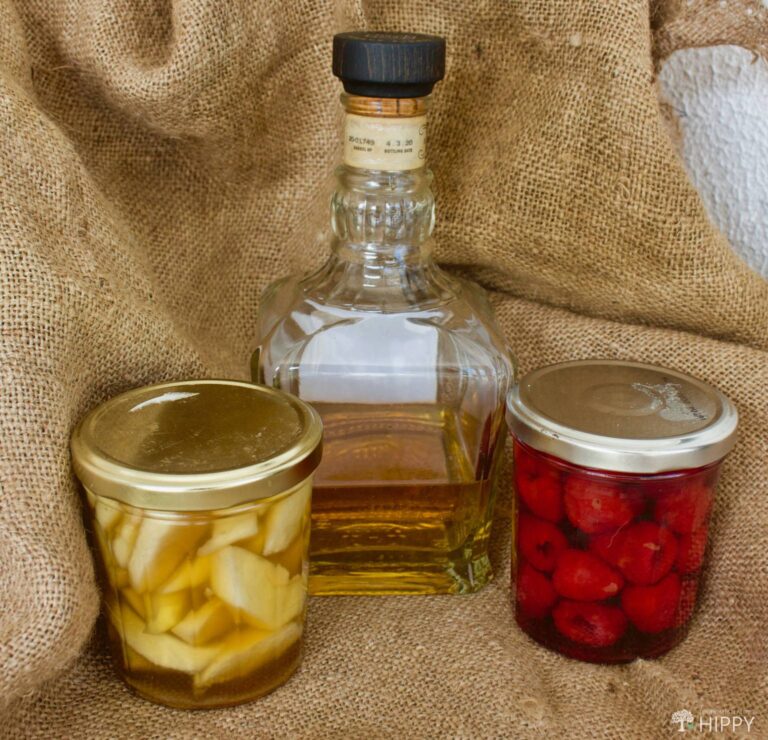
You can make nearly any fruit into brandied fruit. The best stone fruits to add to brandy are peaches, apricots, and cherries.
Berries such as blueberries, strawberries, or raspberries will also work, but they may become very soft and mushy, so are probably not advisable if you are concerned about presentation, but they are absolutely delicious spooned over ice cream or a hot pudding and look good on cakes, or added into baking mixes.
The reason they are great for pantry storage is that the brandy and sugar act as a preservative. There is no need to process this fruit in a canner, as the sugar and alcohol will act as the preservative
The fruit will be ready after four weeks. To serve, simply spoon the fruit over cakes or ice cream. Other ways to enjoy brandied fruit:
- Baking into a brandied fruit cake
- Adding to sangrias, or brandied fruit cordial
- Muddling into a glass with mineral water
- Blending into a cake frosting or topping
- Layering on top of turkey or roasts for additional flavor
- Blending into an adult jam for crackers and cheese plates
- Serving with adult pancakes
- Blending into a brandied fruit compote
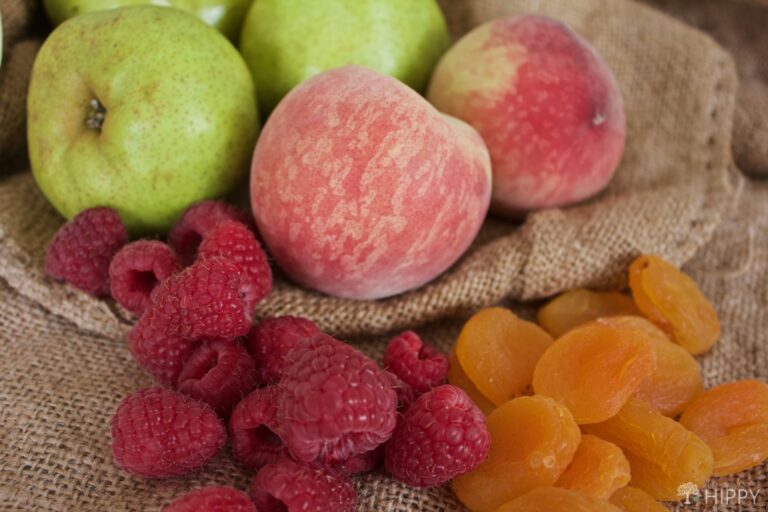
Which fruit is good to make into brandied fruit?
Some suggestions for fresh fruit to preserve in brandy include:
- ☑ Peaches – yellow cling are particularly good
- ☑ Pears
- ☑ Cherries
- ☑ Raspberries
- ☑ Blueberries
- ☑ Mulberries
- ☑ Plums
- ☑ Melon – cantaloupe, honeydew
- ☑ Apricots
You can use a single type of fruit in the jars, or a combination of fruit types. The fruit is usually fresh, but you can also use dried fruit. A recipe from Holland called Boerenmeisjes, which means farmer girls, preserves dried apricots in brandy.
There are lots of recipes for canning apples with cinnamon, but these involve the traditional canning recipe with boiling a syrup, adding some brandy to give a flavor.
However, because these recipes call for boiling the brandy most of the alcohol content is lost, and this article is concerned with a quick way of preserving the fruit without the hot canning method.
Remember, with our brandied fruit recipe, do not heat the brandy as this destroys the alcohol content, and we need the alcohol and the sugar to act as preservatives for the fruit – besides being intoxicatingly yummy.
What if the Fruit Seems Watery?
Sometimes the fruit in your brandied mix can seem watery after it has been soaked in the brandy mixture.
If this happens, there are a few things you can do to fix it. First, try adding more sugar to the mixture. This will help to thicken the liquid and make the fruit taste sweeter.
You can also try simmering the mixture for a longer period of time. This will evaporate some of the excess liquid and give the fruit a more concentrated flavor.
Finally, if all else fails, you can always drain the excess liquid off before serving.
Wash Fruit Before Starting
Fresh fruit should be properly washed, cut and examined and any bruised sections discarded.
Where did the idea of brandied fruit come from?
We are not too sure exactly who first thought of the idea, but the Dutch were great at making brandy and would probably have experimented with fruit added to brandy.
We do know that in the 1700’s in the Alsace region of France, bottles were placed over a budding pear tree and fastened into place, allowing a full size pear to grow inside. The bottle with the pear in it is then cleaned and topped with brandy.
This tradition continues today with premium brandy sold with a pear in the bottle, motivating conversations about how it got in there – and even more intriguing, how to get it out.
About the only way is to use a length of piano, or similar type, wire, make a small loop, insert the length into the bottle and cut off small pieces of the pear – after the alcohol has been consumed, of course.
We are taking the easy way and cutting up the pear, then putting it in the bottle with the brandy so it’s easy to spoon out the fruit.
OK, not quite the conversation starter of the whole pear in a bottle method – but if you do have a pear tree, why not give it a try.
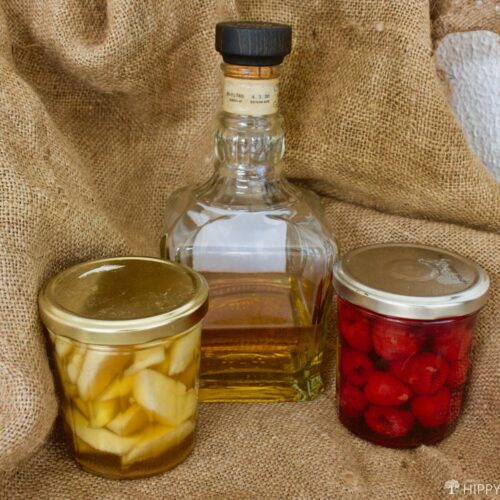
Brandied Fruit Recipe
Equipment
- Sharp knives
- Cutting board
- Assortment of mixing bowls
- Clean jars and lids
Ingredients
- 2 cups fruit of choice
- 1 cup brandy approx.
- 2/3 cup white sugar
- 2/3 cup soft brown sugar
Instructions
- Peel, pit and cut the fruit into slices or chunks. If you are doing cherries, just pit and leave whole. Raspberries, blackberries, and other similar berries can be left whole.
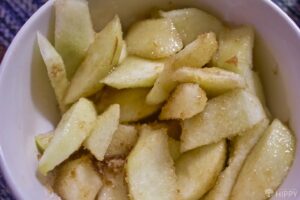
- Mix the sugar together in a bowl and add the fruit, tossing very gently so the fruit is covered in the sugar mix and set aside for an hour.
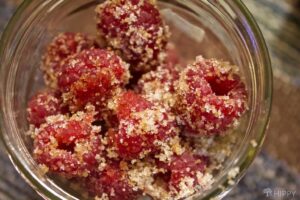
- Make sure your jars and lids are clean and sterilized. You can do this by placing them in the dishwasher for an hour on the sanitize cycle. This is something you can be working on while the fruit is soaking in the sugar mixture.
- Place the fruit in the jar and pour over the brandy to cover the fruit. Gently turn the jar upside down to allow air pockets to escape and brandy to penetrate the fruit.
- Stir and allow the sugar to dissolve.
- After a day open and check the jar as the fruit absorbs the brandy and it may not be covering the fruit, so you might need to top up with a little more brandy.
- Cap the jar again and leave the jars in a cool dark place to mature, giving them a gentle shake every couple of days to ensure even penetration of the brandy into all parts of the fruit.
- After one month the fruit will be ready to start using. At this stage transfer to the refrigerator and use within three months.
How to Store Brandied Fruit
Once the fruit is well coated, store it in a jar on the counter at room temperature.
/As you enjoy the fruit, be sure to top off the jar with more fruit and brandy as needed so that the fruit is always completely covered.
Brandied fruit will last for several months and is the perfect way to enjoy the taste of summer all year long.
Final Thoughts
While canning is a popular way to preserve fruit, it’s not the only option. If you want to try something different this year, give brandied fruit a go. It’s easy to make and doesn’t require any special equipment or ingredients.
Just be sure to start early so you have plenty of time for the fruit to soak in the liquor. Have you ever made brandied fruit? What tips would you add?
FAQ
When you brandy fruit, you are essentially soaking the fruit in alcohol. This process releases the natural sugars in the fruit, and the result is a sweet, delicious treat that is packed with flavor. While there is no definitive answer as to how much alcohol is actually in brandied fruit, it is safe to say that there is definitely some alcohol content.
Some people like to soak fruit in brandy for a brief period of time, while others prefer to let the fruit soak for longer. Ultimately, it is up to the individual to decide how long to soak fruit in brandy.
There are a few factors to consider when making this decision…
First, think about how strong you want the flavor of the brandy to be. If you want a subtle flavor, then soaking the fruit for a shorter period of time will be sufficient.
However, if you want a stronger flavor, then you will need to soak the fruit for a longer period of time. Second, consider the type of fruit you are using. Softer fruits, such as berries, will absorb the brandy more quickly than harder fruits, such as apples.
As a result, you will need to soak softer fruits for a shorter period of time than harder fruits. Finally, keep in mind that the longer you soaked the fruit, the more alcohol will be present in the finished product.
Yes, you can freeze brandied fruit. However, there are a few things to keep in mind. First, the freezing process will stop the flavor development, so your brandied fruit will taste less intense than if you had let it continue to steep.
Second, frozen brandied fruit will be mushier than fresh fruit, so it’s not ideal for eating out of hand. Finally, you’ll need to thaw the fruit before using it in recipes.
It’s important to note that brandied fruit and fruit brandy are not the same thing. Brandy is a distilled spirit made from wine or other fermented fruit juice.
To make fruit brandy, the first step is to macerate the fruit in sugar until the juices are released. This can be done by mashing the fruit by hand or using a food processor.
Once the fruit is sufficiently macerated, the mixture is placed in a fermentation vessel with yeast and allowed to ferment for several weeks.
After fermentation is complete, the brandy is distilled in a copper still and then aged in oak barrels. As you can see, the process is quite different.
What are some ways you would enjoy brandied fruit? Which one would you try first?
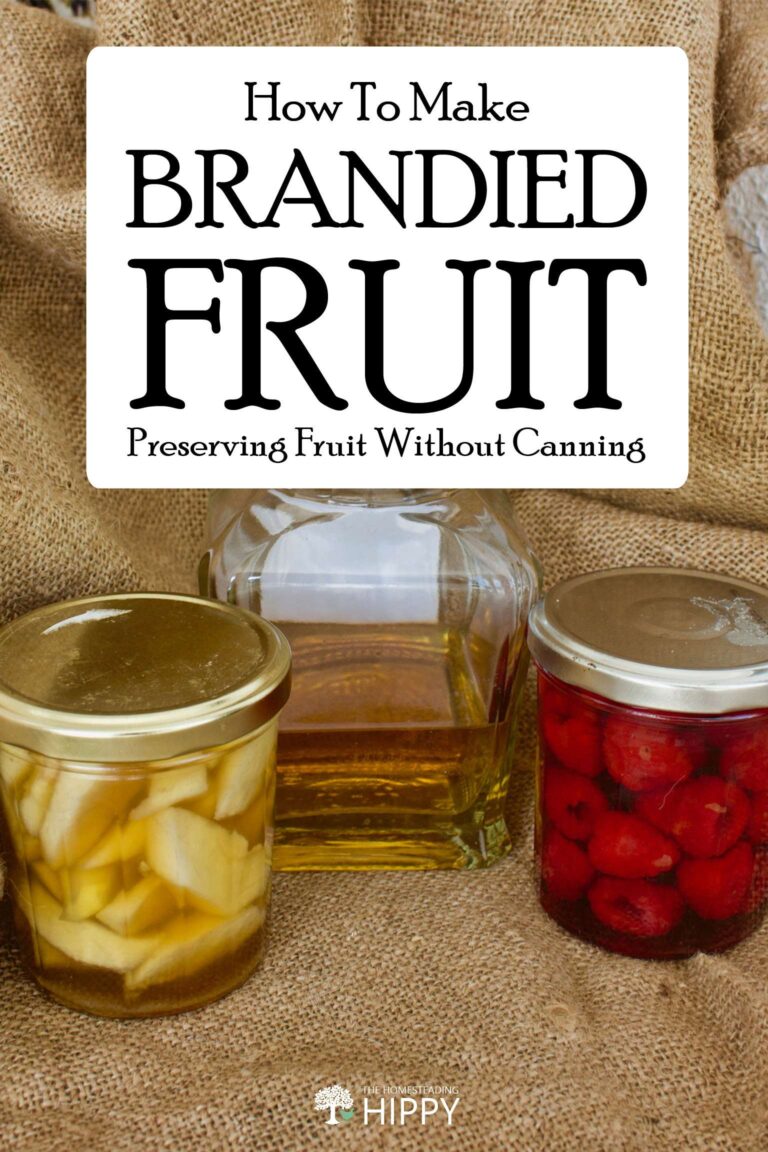

Heather’s homesteading journey started in 2006, with baby steps: first, she got a few raised beds, some chickens, and rabbits. Over the years, she amassed a wealth of homesteading knowledge, knowledge that you can find in the articles of this blog.
Learn more about Heather and the rest of the writers on this page.

Hi, I’m not sure I understand the recipe. Do you use 1 1/2 cups of brandy for each pint jar, or 2 cups? It says both. Thanks!
I’m presuming since the alcohol & sugar preserve the fruit (preventing bacteria, mold, etc to form), you will need enough to keep the fruit covered.
How long is the shelf life?
If you simmer the brandy, will that neutralize the alcohol? If so, how does it still preserve the fruit?
The alcohol is lost when heating. You are to make a simple syrup and let cool and then add your brandy, rum or whatever you want to use. I made some with rum. So yes you need to keep the alcohol content high to preserve the fruit.
I’m confused, instruction #5, bring to a simmer. Bring what to a simmer. The fruit is already in the jars isn’t it. I would love to make this recipe but I don’t understand it.
My father in law kept brandied cherries on the countertop all the time and would put a spoonful on vanilla ice cream, yum! He would just add a little more brandy, sugar and cherries to the pot when needed.
We tried this for the first time ever. We did it in early October. Now it’s mid-December, and noticed today that one of our 5 jars is bubbling a little. Does it mean it has gone bad?
I made brandied fruit in 1971 in antique blue canning jar w wax paper and original metal lid added to it and used for many years. I’ve kept that jar w/o opening all this time… I opened it now 52 years later the fruit is mush dark brown but the strong brandy smell is amazing. I added more brandy and sugar a few days ago put on new wax paper and replaced the lid … won’t be eating the fruit,,,looks awful but think I’ll try the 59 year old brandy….
Then stink I’ll pour it all out and start a new batch. Thanks for the article